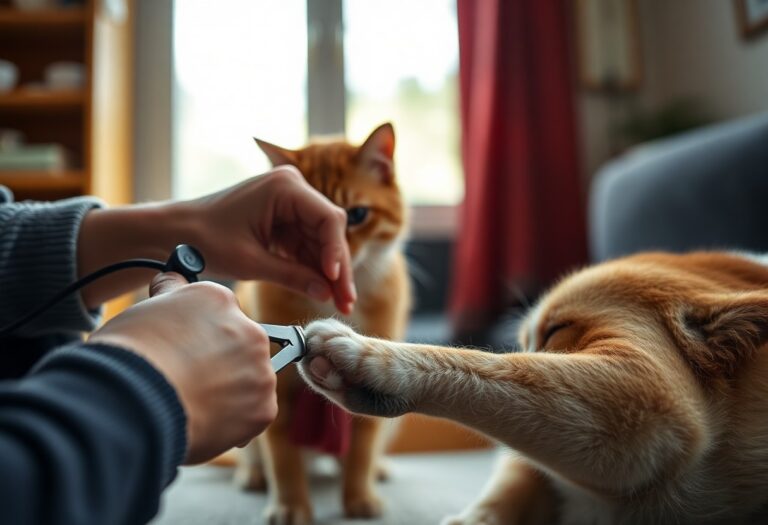Many pet owners overlook the serious threat of heartworms, which can be lethal to dogs and cats if left untreated. These parasites are transmitted through mosquito bites and can cause severe health issues, including lung damage and heart failure. It’s necessary to take proactive steps to protect your furry friends, such as regular preventive treatments and annual veterinary check-ups. By staying informed and vigilant, you can ensure a long, healthy life for your beloved pets and keep them safe from these dangerous parasites.
Unmasking the Heartworm Lifecycle
The Journey from Mosquito to Pet
The lifecycle of heartworms begins with a simple but deadly transfer mechanism involving mosquitoes. When an infected mosquito bites your pet, it injects small, immature heartworm larvae known as microfilariae into the bloodstream. These larvae then migrate through your pet’s system, taking about 6 to 7 months to mature into adult heartworms, which typically reside in the heart and pulmonary arteries. An adult heartworm can grow to be up to a foot long, and a single infected dog can harbor as many as 250 adult heartworms at one time, making the potential for severe health issues substantial.
After the heartworms reproduce, their offspring, or microfilariae, circulate through the blood. If another mosquito bites your infected pet, it can pick up these microfilariae and continue the cycle, thus spreading the danger. The alarming aspect is that pets often show no symptoms until the infestation is severe, which underscores the need for regular heartworm testing and preventative measures.
Fluctuating Climate and Its Impact on Heartworm Geography
Heartworm prevalence can change significantly based on climatic variations. Warmer temperatures increase mosquito populations and extend their active seasons, providing more opportunities for the disease to spread to pets. In regions where temperatures typically hover above 60°F (16°C), heartworm disease becomes a persistent threat. As climate patterns shift due to global warming, you might find areas previously deemed “safe” becoming susceptible to outbreaks as mosquitoes thrive and migrate to new locations.
Additionally, the increase in extreme weather events can create more stagnant water bodies, which serve as ideal breeding grounds for mosquitoes. This connection between climate and mosquito viability expands the geographic reach of heartworm, challenging the previously established borders of where your pet may be at risk. Regular climate-related monitoring is vital for pet owners to understand the potential for heartworm disease in their area.
Moreover, studies indicate that regions experiencing fluctuating precipitation levels may also contribute to increased heartworm transmission rates. Environments that experience heavy rains followed by dry spells tend to promote mosquito populations that can breed rapidly. This adaptability of mosquitoes to different climatic conditions emphasizes the importance of maintaining consistent heartworm prevention measures irrespective of changes in weather patterns.
The Unseen Dangers: Symptoms and Consequences
Initial Signs of Infection
Identifying heartworm infection in its early stages can often be tricky, as symptoms can easily be mistaken for other conditions. You might first notice your pet exhibiting a slight cough, lethargy, or a reluctance to engage in physical activity. Many pets will experience weight loss or difficulty breathing as the infection progresses. These signs can easily blend into your pet’s daily behavior, creating a false sense of security while the situation worsens. Paying attention to subtle changes in your pet’s routine or energy levels is imperative for catching heartworm in its early stages.
In some cases, heartworm-infected dogs may display swollen bellies due to fluid accumulation, which signals advanced disease. This symptom often arises when the larvae develop into adult worms over the course of several months, leading to serious complications. If you notice any of these initial signs, consulting your vet for diagnostic testing is the best course of action to swiftly address potential heartworm infection.
Long-term Health Effects if Left Untreated
If your pet’s heartworm infection goes undiagnosed and untreated, the implications can be dire. Adult heartworms can grow up to a foot in length and reside in the heart and pulmonary arteries, leading to severe cardiovascular complications. Over time, your pet may suffer from conditions such as congestive heart failure or severe lung disease. The presence of these parasites will continually disrupt your pet’s cardiovascular health, resulting in increased stress on their heart and vital organs.
Long-term consequences can manifest as persistent coughing, fatigue, and even fainting spells. The damage done to your pet’s lungs and heart can lead to more complex medical issues down the line, such as organ failure. In fact, studies show that untreated heartworm disease can reduce your pet’s lifespan significantly, with some estimates indicating a decrease of one to three years in quality and longevity. The emotional toll of living with a pet in such a deteriorating state is also considerable, not to mention the financial burden that can come with emergency treatments that may have been avoidable with early intervention.
Prevention Strategies That Really Work
Essential Medications and Their Timings
To keep your pet protected from heartworms, administering preventive medications at the right time is key. Heartworm preventatives, such as those containing ivermectin or milbemycin oxime, are designed to eliminate any larvae your pet may have been exposed to in the previous month. For most dogs and cats, starting this medication before the onset of mosquito season and continuing through fall is vital. In areas with year-round mosquito activity, year-round treatment is necessary. Following the recommended schedule can significantly reduce the risk of a serious infection.
Veterinarians typically suggest testing your pet for heartworms annually before renewing prescriptions. This ensures that any existing infections are caught early, as heartworm treatments can be intensive and risky. In certain regions where heartworms are a known risk, discussions with your vet about high-quality prophylactic options becoming available might furnish you with additional choices tailored for your pet’s unique situation.
Lifestyle Adjustments for High-Risk Areas
Making lifestyle adjustments can enhance your pet’s safety, especially if you live in a high-risk area for heartworms. Mosquito control in your yard is one of the most effective strategies. Clearing standing water, which serves as a breeding ground for mosquitoes, and using pet-safe insect repellents can diminish their presence. During peak mosquito hours, typically from dusk to dawn, keeping your pet indoors can further reduce exposure and risk.
Implementing a heartworm test and medication plan in consultation with your vet is foundational, but complementing these efforts with environmental management showcases your commitment to your pet’s well-being. Discussing the best practices for preventative care with your veterinarian can refine your approach to heartworm prevention, ensuring a holistic strategy that fortifies your pet’s defenses.
The Role of Regular Vet Check-ups
Importance of Testing for Early Detection
Regular vet visits include heartworm testing as a vital part of your dog’s health check. Early detection significantly increases the chances of effective treatment before the disease progresses to a severe stage. The American Heartworm Society emphasizes that heartworm tests, which are usually conducted annually, can identify the presence of adult heartworms even before clinical symptoms develop. This proactive approach allows you to take swift action, thereby minimizing health complications or the need for more aggressive treatments later on.
Understanding the specific risk factors in your area can also prompt testing frequency adjustments. For instance, regions with higher mosquito populations warrant more diligent heartworm screenings. If your dog ever exhibits signs such as coughing or lethargy, seeking an appointment may lead to an early diagnosis. Your veterinarian will guide you on how testing fits into your pet’s overall health plan, ensuring that you’re not only preventing but also catching any potential heartworm problems in their infancy.
What to Expect During a Routine Heartworm Test
During a routine heartworm test, you can expect your veterinarian to perform a simple blood test that screens for heartworm antigens. This test typically takes only a few minutes and can provide immediate results, giving you peace of mind about your pet’s health status. Veterinarians usually recommend this test for any dog over six months old, especially if they haven’t been on preventive medication consistently. In some cases, a follow-up test may be suggested if your dog has been around other pets or in potentially infected areas.
If the test yields a positive result, don’t panic. Follow-up examinations will help clarify the stage of infection and appropriate treatment options. In many cases, the disease can still be managed effectively, especially if caught early. The process is straightforward; your vet will confirm the results, discuss treatment options, and lay out a safe recovery plan tailored specifically for your dog’s condition.
To make the testing and overall vet visit more comfortable for your pet, you can bring along their favorite toy or treat. Familiar scents and items can help ease any anxiety they may feel. Additionally, be open with your vet about your pet’s lifestyle, including any changes in behavior or health you’ve noticed. This communication will provide imperative context that can assist in the effective monitoring of your dog’s heart health.
Real-Life Accounts: Pets Who Battled Heartworm
Success Stories of Recovery
Many pet owners have faced the daunting challenge of a heartworm diagnosis, only to witness their beloved companions emerge stronger than ever. Take Bella, for instance. After a routine vet visit revealed a heartworm infection, her owner spiraled into despair. Yet, with a dedicated treatment plan involving strict bed rest and a series of targeted medications, Bella began to thrive. Within six months, her follow-up tests showed a significant reduction in the heartworm burden, and today, she runs and plays with the vigor of a puppy. There are numerous cases like Bella’s, where the combination of timely intervention and a loving owner environment led to remarkable recoveries.
Lessons Learned from Heartworm Diagnoses
Each heartworm diagnosis brings valuable lessons to pet owners and veterinarians alike. The importance of regular check-ups cannot be overstated, as early detection can significantly improve treatment outcomes. Furthermore, many owners who have navigated this difficult path emphasize the need for consistent administration of preventative medications, regardless of perceived risk levels. Heartworm is not just a concern in warmer climates; infections have been reported even in traditionally cooler areas. By staying vigilant and informed, you can safeguard your pet against potential infections.
Reflecting on the experiences of those who have faced heartworm, it becomes evident that education is a powerful tool. Pet owners often share that knowledge about heartworm was somewhat lacking until they encountered the issue firsthand. This underscores the necessity of spreading awareness regarding effective prevention strategies and the true risks associated with heartworms. Keeping your dog up-to-date with vaccinations, preventing mosquito exposure, and understanding the life cycle of the heartworm can dramatically reduce the odds of an infection.
Final Words
Hence, safeguarding your pet from the dangerous threat of heartworms involves a combination of proactive vet visits, preventive treatments, and regular check-ups. By ensuring your furry friend is on a consistent heartworm prevention regimen, you drastically reduce the risk of this potentially fatal disease. Additionally, staying informed about the environmental factors that contribute to heartworm transmission can empower you to make informed decisions regarding your pet’s outdoor activities and living conditions.
Ultimately, the health and well-being of your pet are in your hands. By prioritizing prevention and monitoring, you can keep your beloved companion safe from the perils of heartworms. Your commitment to their health not only prolongs their life but enhances the quality of those years spent together. Investing in their safety is an investment in their happiness and yours.







